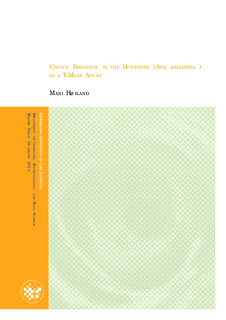| dc.description.abstract | Abstract
The study of eusocial insects such as honeybees (Apis mellifera) has seen advancements in recent decades. This study offers a contribution to the understanding of choice behavior in honeybees, by conducting experiments on the ligustica and carnica races in a T-maze assay. Experiments were carried out using two different factors to motivate choice: In a social choice experiment newly emerged and adult carnica winter bees and newly emerged ligustica bees were presented with the choice between a familiar bee and an unfamiliar bee. In a feeding partner experiment adult carnica winter bees and two genetic strains of newly emerged ligustica bees, high pollen hoarders (highs) and low pollen hoarders (lows), were presented with the choice between two unfamiliar bees which had been fed high (50%) and low (10%) concentrations of sucrose.
Results showed that the T-maze can be a useful tool in studying the choice behavior in honeybees. Adult carnica winter bees showed a bias towards the unfamiliar bee, while newly emerged bees were consistent in that they did not share this preference, indicating a development in choice behavior with age. The low pollen hoarders were compared with the high pollen hoarders and showed a relative bias towards the high sucrose bees, possibly owing to their lower sensitivity towards sucrose. Results also indicate that the lows had a higher activity level than the high. However, inconsistency between the observed and calculated rates of movement suggests that the sampling frequency in this experiment was too low to accurately capture the activity level.
Sammendrag
Studien av eusosiale insekter som honningbia (Apis mellifera) har utviklet seg de siste tiår. Denne studien gir et bidrag til forståelsen av valgatferd hos honningbia, ved at eksperimenter med bier fra de to rasene ligustica og carnica har blitt utført i en T-labyrint. Experimentene utforsket to motivasjoner: I eksperimenter med nykrøpne- og voksne vinterbier av carnica-rasen,og nykrøpne bier av ligustica-rasen, ble sosiale valg utforsket ved biene fikk velge mellom en kjent og en ukjent bie. I fôringspartner-eksperimenter fikk voksnebier fra carnica-rasen og nykrøpne bier fra to genetiske stammer av ligustica-rasen, ”high pollen hoarders” (highs) og ”low pollen hoarders” (lows) , valget mellom to ukjente bier som hadde blitt fôret med høy (50%) og lav (10%) konsentrasjon av sukkervann.
Resultatene viste at T-labyrinten kan være et nyttig verktøy i studiet av valgatferd hos honningbia. Voksne carnica-vinterbier viste en tilbøyelighet til å velge ukjent bie, mens de nykrøpne var konsekvente i den forstand at de ikke delte denne preferansen, noe som indikerer at valgatferd utvikles med alderen. ”Low pollen hoarders” ble sammenlignet med ”high pollen hoarders”, og utviste større preferanse for bia som hadde spist høy konsentrasjon av sukkervann, noe som kan forklares med at de er mindre sensitive overfor sukker. Resultatene indikerer også at lows hadde et høyere aktivitetsnivå enn highs, men beregnet aktivitetsnivå stemte imidlertid ikke overens med det som faktisk ble observert. Dette kan tyde på at frekvensen på prøvetakingen var for lav til at aktivitetsnivået ble nøyaktig målt. | en_US |
